

Squeezing transistors really hard generates energy savings. Transistors, the workhorses of the electronics world, are plagued by leakage current.
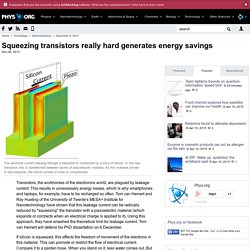
This results in unnecessary energy losses, which is why smartphones and laptops, for example, have to be recharged so often. Tom van Hemert and Ray Hueting of the University of Twente's MESA+ Institute for Nanotechnology have shown that this leakage current can be radically reduced by "squeezing" the transistor with a piezoelectric material (which expands or contracts when an electrical charge is applied to it). Using this approach, they have smashed the theoretical limit for leakage current.
Tom van Hemert will defend his PhD dissertation on 6 December. If silicon is squeezed, this affects the freedom of movement of the electrons in this material. Only pinch when necessary In modern microchips, every single transistor is continuously exposed to enormous pressures of up to 10,000 atmospheres. Limit smashed. A 2,000 YEAR OLD ELECTRIC BATTERY. Energy Harvesting. Wireless sensor networks consist of numerous small devices all interacting to observe an environment and assemble useful data about that environment.
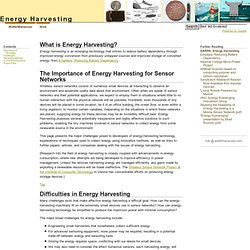
Often when we speak of sensor networks and their potential applications, we expect to employ them in situations where little to no human interaction with the physical network will be possible. Hundreds, even thousands of tiny devices will be placed in some location, be it in an office building, the ocean floor, or even within a living organism, to monitor certain variables. Depending on the situations in which these networks are placed, supplying energy for these devices may be an incredibly difficult task. Energy Harvesting proposes several potentially inexpensive and highly effective solutions to such problems, enabling the tiny machines involved in sensor networks to collect energy from some renewable source in the environment. Characterising Piezoelectric materials for 10x faster computing. A unique international research collaboration is working to develop technologies to help deliver 10 fold increases in chip processor speed, faster internet connections and huge energy savings worldwide.
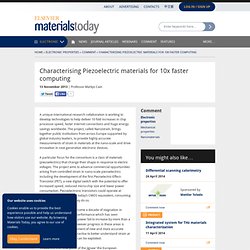
The project, called Nanostrain, brings together public institutions from across Europe supported by global industry leaders, to provide highly accurate measurements of strain in materials at the nano-scale and drive innovation in next generation electronic devices. A particular focus for the consortium is a class of materials (piezoelectrics) that change their shape in response to electric voltages. The project aims to advance commercial opportunities arising from controlled strain in nano-scale piezoelectrics including the development of the first Piezoelectric-Effect-Transistor (PET), a new digital switch with the potential to offer increased speed, reduced micro-chip size and lower power consumption.
Specialized Circuit Drives 150-V Piezoelectric Motor Using Low-Voltage Op Amp. A piezoelectric motor is a linear motor with bidirectional motion.

It uses friction to grip the armature while a voltage is ramped to warp the piezoelectric material and move the armature. The voltage then is quickly removed. As the material springs back, it breaks away from the armature and returns to its zero position, leaving the armature a few micrometers further along its track. Repeat this at a kilohertz rate and for thousands of times. While each of the motions is very small, after several seconds you may see that the armature has moved, if you look carefully. There are two drive waveforms, one for forward and the other reverse: a sawtooth waveform with a slow linear rise followed by a fast fall, and its complement with a fast rise and slow linear fall. The problem is the voltage. Q = It = CV. Optimal observability-based modelling, design and characterization of piezoelectric microactuators - Abstract - Smart Materials and Structures.
Piezoelectric windstalks. Cree`s LED upgrade kit could finish off linear fluorescents. June 05, 2013 The firm's new breakthrough technology delivers contractors quick Retrofit to LED lighting Linear fluorescent lighting may have seen its last days thanks to the inventive, new Cree UR Series LED Upgrade Kit.

Cree says it can deliver payback in less than two years and makes upgrading to LED lighting simple and easy. Payback has been calculated against a fluorescent three-lamp fixture (with lamp and ballast equal to 88 system watts) and based on typical commercial usage of 12 hours per day and $0.11 per kWh electric costs.
Apple's haptic touch feedback concept uses actuators, senses force on iPhone, iPad. By Neil Hughes In an effort to make touchscreens less static, Apple has proposed that future iPhones and iPads could feature actuators that would provide haptic feedback to users, and also include sensors that would measure the force at which a user touches the screen.

The concept was unveiled this week in a patent application discovered by AppleInsider entitled "Touch-Based User Interface with Haptic Feedback. " The use of actuators underneath a touchscreen could allow users to actually feel elements on the screen, such as buttons or controls. The timing of the application being made public by the U.S. Boosting LED Efficiency: Zinc Oxide Microwires Improve Performance of Light-Emitting Diodes (LEDs) Through the Piezo-phototronic Effect. Researchers have used zinc oxide microwires to significantly improve the efficiency at which gallium nitride light-emitting diodes (LED) convert electricity to ultraviolet light.

The devices are believed to be the first LEDs whose performance has been enhanced by the creation of an electrical charge in a piezoelectric material using the piezo-phototronic effect. Georgia Tech Regents professor Zhong Lin Wang (right) and graduate research assistant Ying Liu study light-emitting diodes whose performance has been enhanced through the piezo-phototronic effect. (Click image for high-resolution version. Credit: Gary Meek) By applying mechanical strain to the microwires, researchers at the Georgia Institute of Technology created a piezoelectric potential in the wires, and that potential was used to tune the charge transport and enhance carrier injection in the LEDs. Researchers aim to close 'green gap' in LED technology. A team of researchers from Rensselaer Polytechnic Institute has received $1.8 million in federal funding to improve the energy efficiency of green light-emitting diodes (LEDs).
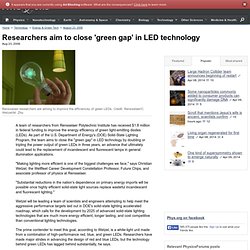
As part of the U.S. Department of Energy's (DOE) Solid-State Lighting Program, the team aims to close the "green gap" in LED technology by doubling or tripling the power output of green LEDs in three years, an advance that ultimately could lead to the replacement of incandescent and fluorescent lamps in general illumination applications. "Making lighting more efficient is one of the biggest challenges we face," says Christian Wetzel, the Wellfleet Career Development Constellation Professor, Future Chips, and associate professor of physics at Rensselaer. "Substantial reductions in the nation's dependence on primary energy imports will be possible once highly efficient solid-state light sources replace wasteful incandescent and fluorescent lighting.
" Wetzel will be collaborating with co-principal investigator E. Triboelectric Energy: The Future Of Renewable Power? By EarthTechling's Pete Danko: Where there’s power being produced, there are researchers looking into how it might be harvested and put to use, no matter how small the amount.
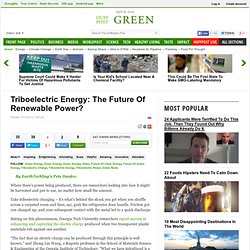
Take triboelectric charging – it’s what’s behind the shock you get when you shuffle across a carpeted room and then, say, grab the refrigerator door handle. Friction got you charged up, and your subsequent contact with the metal led to a quick discharge. Seizing on this phenomenon, Georgia Tech University researchers report success in enhancing and capturing the electric charge produced when two transparent plastic materials rub against one another. “The fact that an electric charge can be produced through this principle is well known,” said Zhong Lin Wang, a Regents professor in the School of Materials Science & Engineering at the Georgia Institute of Technology.
MIT Develops an Energy-Harvesting Chip That You Can Shake and Bake ( - Consumer Electronics ) Over the years, we've seen researchers develop some rather unorthodox energy harvesting systems, including photovoltaics (solar panels), piezoelectric materials that react to motion, and thermoelectrics that turn heat into electricity. Now, MIT Professor of Electrical Engineering Anantha Chandrakasan and MIT doctoral student Saurav Bandyopadhyay are working on a chip that can harvest energy from all three of the same sources at the same time.
According to the researchers, the chip can generate up to 0.15 volts from thermal differences, 0.7 volts from natural light, and five volts from vibrations. While each power source only produces a small amount of electricity, the researchers have found a way to effectively combine the energy from all three methods by rapidly switching between them. Atelier DNA. Entry for 'Land art generator' competition. Second Prize Winner. 2010. Masdar U.A.E. Our project starts out as a desire, a whisper, like grasping at straws, clenching water. Leader in Piezoelectric Actuator Technology, PZT Material. The Road - The Trip For Life. The world we live in is one where many people have poor eyesight, but surprisingly few can afford corrective lenses so that they can see clearly.
This is because of the basic design of corrective optics; they have to be custom made for every frame and eyesight combination, and this greatly increases the cost. Some places, such as Zenni Optical, cut costs by pre-building lenses for every combination with a computer controlled system, and stockpiling them. This works to cut the cost down to less than 50 dollars or so, but that's still far outside the means of many of the poor, particularly in disadvantaged countries. Other efforts have focused upon making cheap, adjustable optics to serve these populations; for instance, Adaptive Eyecare of Oxford has developed lenses that use adaptable lenses filled with optically clear fluid; pumping more fluid between the optical membranes increases the deflection of the resulting lens, and thus increases the effective diopter of the lens.
New MIT chip harvests energy from three sources. The problem with depending on one source of power in the drive toward the battery-free operation of small biomedical devices, remote sensors and out-of-the-way gauges is that if the source is intermittent, not strong enough or runs out altogether, the device can stop working.
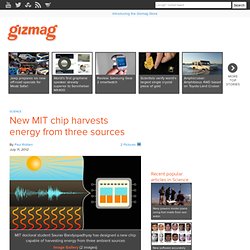
A small MIT research team has developed a low-power chip design capable of simultaneously drawing power from photovoltaic, thermoelectric, and piezoelectric energy sources. The design also features novel dual-path architecture that allows it to run from either onboard energy storage or direct from its multiple power sources. Previous research projects at the lab of MIT's Head of the Department of Electrical Engineering and Computer Science, Prof. Anantha Chandrakasan, have led to developments of super-low-power wireless communication and computer chips that have their power needs satisfied by either natural light, heat or vibrations. MIT develops energy-harvesting chip. Ultrasonic Transducers, Piezoelectric vs Electrostatic. Piezoelectric vs Electrostatic Ultrasonic transducers come in two basic types, piezoelectric and electrostatic. The main difference between the two is that piezoelectric transducers use a ceramic material whereas electrostatic transducers contain a thin metal membrane.
While their materials differ, they both rely on the piezoelectric effect in order to function. This effect has two parts to it. First, when an electrical current is applied to the material, the material changes shape which results in an ultrasonic sound wave. MIT Chip Harvests Energy from Heat, Light and Movement. Researchers at MIT have developed a new chip that can continually and almost simultaneously draw energy from three different sources. The chip is designed to harness thermoelectric (heat), photovoltaic (light) and piezoelectric (movement) energy. The new chip either runs directly off of that energy or off of onboard energy storage. Earlier, MIT’s Department of Electrical Engineering and Computer Science had come out with chips that could power itself of heat, light or vibrations. However, such chips simply switched among the multiple energy sources, taking advantage of whichever one is generating the most energy at a given point. Highlights of Energy Harvesting & Storage Europe 2012 (Part One) - Energy Harvesting Journal.
Authors: Simon Aliwell, Zartech and Costis Kompis, Vodera. The construction and application of a molecular wire piezoelectric urease-producing bacteria sensor - Analytical Methods. Elektronik Energy Harvesting Congress - Avnet Abacus – Energy harvesting applications to show at inaugural congress. Rutgers MAE Senior Design 2012 Piezoelectric Energy Harvesting Device. Nanogenerators Easier and Cheaper to Produce than Ever Before. Piezoelectric Transducers Unlock New Doors. IDT 4M piezoelectric MEMS oscillators. Piezoelectric Energy Harvesting 2012-2022: Forecasts, Technologies, Players: IDTechEx. Take leisurely stroll‚ charge your cellphone. A virus that creates electricity. Viruses convert movement into electricity - 5/17/2012.
US researchers have converted viruses into a nanowatt piezoelectric power source. The M13 virus is basically a single strand of DNA 880nm long and 6.6nm in diameter, with a coat of 2,700 charged proteins, “and large numbers of the rod-shaped viruses naturally orient themselves into well-ordered films, much the way that chopsticks align themselves in a box”, said the Berkeley Lab, where the work was done.
Already identified as piezoelectric because the helical proteins twist the microbe in an electric field, genetic engineering was used to boost the effect. Four negatively charged amino acid residues were added to one end of the protein to increase the charge difference between its positive and negative ends. Virus Makes Producing Power A Walk In The Park. Government scientists say they have uncovered a way to produce electricity by harnessing the power from simple every day tasks, such as walking or shutting a door.
Energy Harvesting Enabled Device Shipments Will Quadruple by 2015, Forecasts Pike Research. Surface/interface effect around a piezoelectric nano-particle in a polymer matrix under compressional waves. No data available. Please log in to see this content. You have no subscription access to this content. No metrics data to plot. The attempt to load metrics for this article has failed. The Green Advantage - New Technology Harvests Lost Energy - US Business News. “An increasing number of consumer and industrial products that need to become disconnected from the electrical outlet will become powered by some form of energy harvesting in the near future,” says Farouk Balouchi, analyst with cleantech research firm, Pike Research.
Energy prices, along with the costs of maintaining batteries for portable devices, “will motivate consumers and industrial end-users to investigate alternatives involving more autonomous power sources,” says Balouchi. Characterization of a rotary piezoelectric energy harvester based on plucking excitation for knee-joint wearable applications - Abstract - Smart Materials and Structures. Piezoelectric transducer for an audio-prosthesis implantable in the middle ear. Advances in Piezoelectric Transducers. FUTUREWATCH: Will Piezoelectric Energy Replace Batteries? Piezoelectric energy can potentially replace batteries in future. Piezo PowerTech wins Michigan Clean Energy Venture Challenge. Piezoelectric Shoes – The Design Technology Blog. How to Generate Electricity from Kinetic Energy. Oil price rises as EU bans Iranian oil imports. The Future of Piezoelectric Generators. Modeling and Simulation of Piezoelectric Energy Harvester Archive.
Can piezoelectric generators power your home in the near future? Can piezoelectric generators power your home in the near future? IMEC reports record power for micromachined piezoelectric energy harvester" Archive 2009-imec. A hybrid photovoltaic-piezoelectric device. Breakthrough Medical Gadgets: The Future of Healthcare Hardware. Non-Polar Block Copolymer with Piezoelectric Properties One Per Cent: Apple files patent for a tie-clip iPhone loudspeaker. Pakistan_Piezoelectric Solution.wmv. What’s next: Piezoelectric devices to harvest human and machine motion for clean energy. PIEZOELECTRIC CAR IEEE Mechanical Project Idea. Inertial Flow Phenomenon Analysis on Piezoelectric Pump. Piezoelectric Articles. University of Minnesota Digital Conservancy: Development of a piezoelectric weigh-in-motion system for battery-less wireless operation.
A four-state magnetoelectric coupling for embedded piezoelectric/magnetic composites. Theory of piezoelectric materials and their applications in civil engineering. Atelier DNA. Wind Power Without the Blades: Big Pics. PiezoElectric. Scientists Use Zinc Oxide Nanowires to Enhance Performance of LEDs. California studies how to convert road vibrations from cars to usable energy. MIT piezoelectric energy harvesting - Topic - Digital Journal.
ORNL discovers amazing electrical properties in polymers. Thought of Piezoelectric Result Spelled out. [1109.4911] Neutron Production from the Fracture of Piezoelectric Rocks. Maserati Fractal By Liviu Tudoran. Maserati Fractal Concept 'shape shifting' futuristic automobile with an electric attribute.